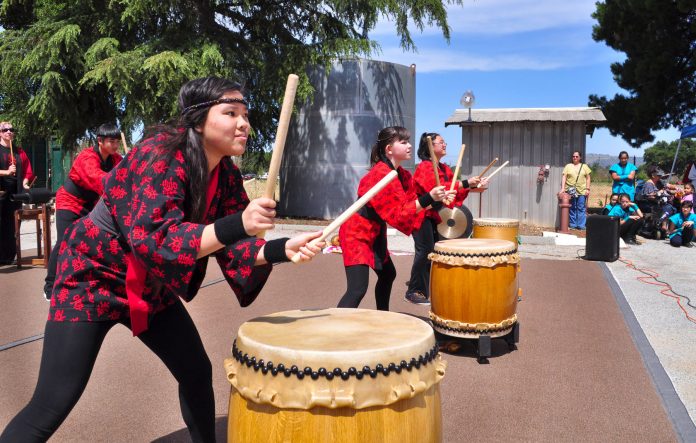
During a warmer than usual Sunday in November 1959, members of the Japanese community in Morgan Hill gathered in a garage to share steaming bowls of white rice, renew friendships and celebrate their proud heritage in the first of many events that led to the founding of the annual Haru Matsuri festival.
Forty-six years later, the festival is now one of the longest running cultural events in Santa Clara County. Last Sunday, more than 3,000 people turned out for the event to experience traditional Japanese cuisine, crafts and music and to celebrate spring.
Rosemary Kamei, a Haru Matsuri volunteer for more than 20 years, said the festival is much more than just food and entertainment. It also provides cultural awareness and insight into the heritage of local Japanese Americans.
“Many people leave the festival with an increased knowledge of our Japanese culture, and it’s a wonderful way to share the coming together of our community in the spring,” Kamei said.
The roots of the festival go all the way back to the alienation of Japanese Americans during World War II, when Issei-first generations to immigrate to the United States from Japan-and Nisei-the second generation born in the states-tried to rebuild their lives after they were freed from internment camps. Dr. Jon Hatakeyama, a Morgan Hill dentist and past chairman of Haru Matsuri, said the Driscoll Fruit Company, still in operation today, helped Japanese Americans by allowing them to become sharecroppers for the company.
“The Japanese Americans were hard working farmers who worked well with other ethnic groups that were also agriculturally based, including the Italian Americans,” Hatakeyama said. “They also sharecropped with Latinos.”
With a need to socialize and share their culture and heritage, some farmers pledged money on behalf of their families and the Morgan Hill Buddhist Sunday School held its first major fundraising event in 1959 to raise operating funds and purchase an altar. The “Oriental Food Sale” with adult and children games and a menu consisting of sushi, chicken teriyaki, spareribs and chow mein, was held at the Friendly Inn on Hale Street, according to festival organizers.
The event was successful and prompted a joint effort between San Jose, Morgan Hill and Gilroy Sunday schools to have another fundraiser, an “Autumn Festival” featuring Japanese cultural exhibits and cuisine, on Sept. 30, 1962.
As the Morgan Hill Sunday School, also known as the Dharma School, became more established, the first local Haru Matsuri was held at the Friendly Inn on March 21, 1965.
Haru Matsuri literally translates to spring festival,” said Paul Yoshikawa, festival publicity chairman. “In Japan, a Haru Matsuri would signify the coming of spring and the planting of crops for a new year.”
The festival was a community event through and through, with the chicken served at the event cleaned at a community member’s home and then barbecued at the Friendly Inn kitchen. Sushi and manju—pastry filled with sweet bean paste—were also prepared.
Many Japanese community members volunteered their time to support the festival in hopes of generating enough funds to build their own facilities. In 1967, that dream finally came true with the completion of the temple building. Construction of a second building, a multi-purpose structure, followed in 1974.
Today the Morgan Hill Buddhist Community Center is a testament to Haru Matsuri, the fundraising quest that began in a garage in 1959 and eventually grew into the South County’s oldest running cultural event. This year marked the festival’s 55th anniversary and also featured the 19th anniversary of the Taiko Expo—the largest gathering of Taiko drum groups in Northern California. Taiko is the Japanese word for drum, but in North America taiko describes both the Japanese drum itself and the art form of ensemble drumming.
The group Tatsumaki Taiko of Berkeley has performed annually in the Taiko Expo at the festival since 2001. Phil Pickering, artistic director, said the Taiko Expo blends perfectly with Haru Matsuri and helps reinforce the festival’s goal to spread awareness of Japanese culture.
“We strive to bring people together through the sound of the taiko, and it’s a way of meeting people from all over who may be experiencing the festival and taiko for the first time,” Pickering said.









